 Most days, we all believe that technology is a great thing for our industry. Most of us are tech geeks at heart. Yet, anytime an innovative, new technology comes out, there are bound to be a few hiccups along the way as the kinks get worked out. This is and has been the case over the last several years as the majority of new carmakers have implemented TPMS — Tire Pressure Monitoring Systems — into their vehicles.
Most days, we all believe that technology is a great thing for our industry. Most of us are tech geeks at heart. Yet, anytime an innovative, new technology comes out, there are bound to be a few hiccups along the way as the kinks get worked out. This is and has been the case over the last several years as the majority of new carmakers have implemented TPMS — Tire Pressure Monitoring Systems — into their vehicles.
As a technician, shop owner or service manager, one of the most common complaints you see now from customers is the TPMS light is on. This symptom is caused by a myriad of reasons ranging from owner error to atmospheric conditions, to true system/component failures. The only problem with creating a device that is a pass/fail-type sensor is that it does just that with no regard for the reasons that cause it. The good news about TPMS signals is two-fold. First and most importantly is that it causes the vehicle owner to think about and react to a potentially deadly condition of low air pressure in their tires. Second and also important to all of our well-beings is that it creates the opportunity for sales and education when the customer comes in for service.
After bringing a customer’s vehicle with the TPMS light on into the shop, we often realize that the customer has not been maintaining his or her vehicle properly by checking air pressure regularly as specified by all the OEMs. In other instances, the vehicle system can be confused due to a rapid change in ambient air temperature causing tire pressure to drop below the preset threshold established by the car manufacturer. In both of these cases, the repair is a quick one where you will clear codes on the vehicle, inflate the tires to the correct pressure and gently remind your customer to check the air pressure once a month! 
In other cases, after diagnosing the vehicle, you will determine that there is truly a fault in the system. In some instances, the air pressure in all the tires is at or within tolerances set by the carmaker. It is in these cases that you will need to implement the assistance of a TPMS diagnostic tool.
The form, ability and, of course, cost of TPMS tools can vary widely. When making your buying decision, you will need to consider first, what form factor tool you want or need. The choices first are a stand-alone device versus a tool designed to be used in conjunction with an existing scan tool. Most of the major suppliers of scan tools now offer some sort of add-on device or software designed to integrate with their diagnostic platform. This type of solution has some pros and cons to it.
The most obvious advantage to using a “bolt-on” solution to your scan tool is cost. Generally, all the major suppliers are currently offering bundled product that includes some sort of TPMS solution with the purchase of a complete diagnostic platform. These tools usually have integrated the operation of the TPMS module directly onto their main operating menus. This alone makes a compelling reason to consider the bundled product. You are able to have a single source for support as well as only using one tool for all your diagnostic needs, including TPMS diagnosis and repair.
One potential reason to not choose this solution is more about convenience than function. The downside to using an integrated solution is the size/weight of most scan tools is larger and less “portable” than some of the smaller dedicated hand-held TPMS tools available on the market. This is purely a subjective decision and one you will have to make on your own. The function of the packaged systems is, in most cases, comparable to the stand-alone devices and, in almost every case, is built in partnership with one of the same suppliers that invented the TPMS technology and sell the tools directly.
Regardless of whether you choose a stand-alone device or an integrated one, you need to think about what types of repairs you will most commonly do and verify the tool you choose can do all of those types of services. Let’s take a look at some of the most common types of activities for TPMS:
• Read Codes
• Clear Codes
• Identify Sensor Data
• Retrain or Initiate Replacement Sensors
These are the most common activities that you will do when working with TPMS. These are pretty self-explanatory, so I won’t spend much time describing these. While the first two need no explanation, identifying sensor data is important for the technician to determine what kind of sensor is on a vehicle. The better tools will help do this quickly and minimize or eliminate false identification in a crowded shop environment. When replacing a sensor on a vehicle, it is necessary to teach the new sensor the vehicle parameters.
One thing that will help you decide which tool you need is how many sensors do you replace? If you are a high volume tire shop or a busy dealership, you need the ability to do everything. The reality is, if you are changing tires, you are going to break a sensor every now and then. Also, the ability to reprogram sensors can create additional income for your business. Many times, smaller shops will sub-out reprogramming sensors to shops that have the right tools. This can be a way for your shop to recover some of your investment in a full TPMS system.
In making your decision which tool you need, be sure to ask your tool supplier about training, after-the-sale service, sensor availability, tool warranty and the ability to update the tool. Some tools are subscription based and at the end of a certain amount of time, you will need to purchase additional coverage.
All in all, TPMS is a great system that will help save lives, and increase tire life and overall vehicle safety. And with all great new technologies, there is bound to be a few bumps in the road as we all catch up to the technology.
Incorporating TPMS Into Your Business
Once the decision to integrate TPMS repair into the business has been made, successful service centers will focus on the three key elements of TPMS service: replacement parts, service tools and technician training.
Replacement Parts:
Selecting high-quality sensors, service packs and accessories for today’s vehicles ensures that quality standards are met and that customers can drive away safely with their TPMS system fully operational.
Service Tools:
A properly stocked repair bay streamlines the repair process and ensures that the required repair elements are available on-demand. An essential piece for TPMS repair, hand-held scan/programming TPMS tools are needed for reading, activating, programming and relearning sensors to the vehicle. They enable technicians to “Test Before You Touch” — checking sensors for functionality, tire pressure, and sharing evidence of TPMS state with the customer prior to beginning the repair, and thus, limiting liability (repair centers won’t inherit others’ problems). Manual torque tools are also needed for torquing valve cores and nuts to the proper specifications.
Technician Training:
Training technicians on proper TPMS procedures is critical. From standard repair protocol and correct use of service packs to customer education, well-trained technicians ensure that TPMS repair is done efficiently and correctly.
By creating a standard process for TPMS repair, the practice will become part of a typical vehicle inspection — and soon as simple and standardized as an oil change.
Courtesy of Schrader International and Bartec USA.









